We sincerely hope that you enjoy this article about 5 Stunning Asian Lepidoptera. Insects such as these represent some of the most colorful and beautiful species on the planet. Of course, these 5 do not even scratch the surface of the more than 180,000 known varieties of Lepidoptera in the world today. But, we hope that you will enjoy learning about these particular few, and wish to learn more about other related species around the world.
Creatonotos gangis
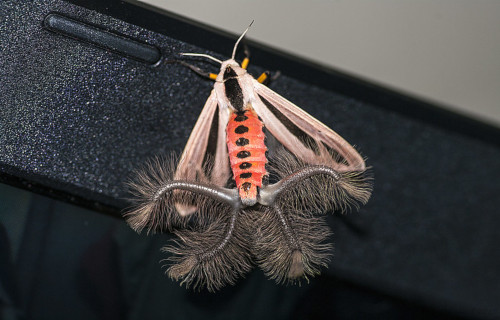
CCL: https://bit.ly/2Cvf1Uh
Creatonotos gangis Facts
- Leading off this listing of 5 Stunning Asian Lepidoptera is one of the most unusual in the world, the Creatonotos gangis.
- Perhaps most notably, the truly astonishing invertebrate remains one of the most visually distinctive Lepidoptera known to man. Unfortunately, the remarkable insect also has no generally accepted common name.
- While it may be unknown to many, the incredible moth inhabits a moderately extensive range. Due to this unfortunate fact, along with an apparently stable population base, the IUCN currently has no listing for the insect.
- Furthermore, while the adults remain completely harmless, the same does not hold true for the caterpillar form. In fact, this life stage of the surprising invertebrate often causes severe damage to pomegranate crops.
- Sadly, however, this could potentially change in the very near future. This lamentable fact occurs for the same reason it does for numerous other species, because of the continued progression of climate change.
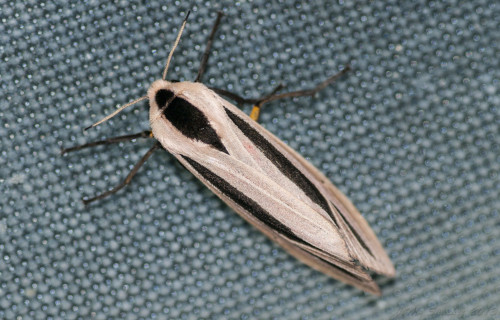
CCL: https://bit.ly/2Q0vSWY
Creatonotos gangis Physical Description
Firstly, despite its astounding appearance, the remarkable Creatonotos gangis remains a physically moderately small type of moth. The fascinating species does display sexual dimorphism, however, but it does so in a highly unusual manner.
Secondly, because of this, both genders attain the same approximate physical size. As a result, mature adults attain an average wingspan of about 1.6 in (4 cm). In addition, both sexes develop brown forewings and white hindwings. Also, both possess a dark streak on each wing, and usually a red abdomen, though yellow does occur.
However, the most startling physical attribute, and the source of the physical difference, belongs to the males of the species. That’s because each male has four large, extendable scent organs. When fully extended, these can even be longer than the body itself.
- Kingdom: Animalia
- Phylum: Arthropoda
- Class: Insecta
- Order: Lepidoptera
- Family: Erebidae
- Genus: Creatonotos
- Species: C. gangis
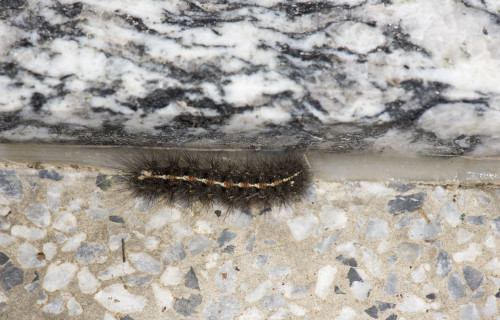
CCL: https://bit.ly/2PZuELs
Creatonotos gangis Distribution, Habitat, and Ecology
First of all, the unique and rather fascinating Creatonotos gangis inhabits a range that includes parts of southeast Asia and Australia. In Asia, this includes parts of a total of seven countries. But, in Australia, this includes Queensland, and parts of the western and northern areas.
Also unlike most related creatures, the awesome Creatonotos gangis inhabits a fairly wide range of habitat types. However, it does show a decided preference for regions with an abundance of fruit trees, most especially pomegranates.
Further, the enormous scent glands of the male allow it to attract females from extreme distances. After mating, the female lays large quantities of round, yellow eggs. These most commonly appear in rows on the underside of plant leaves.
Once hatched, the caterpillar form has a voracious appetite. It feeds on numerous species, of course, but apparently prefers pomegranate leaves. Yet it also consumes the foliage of plants such as rice, sweet potatoes, and sorghum in less damaging quantities.
Green Dragontail
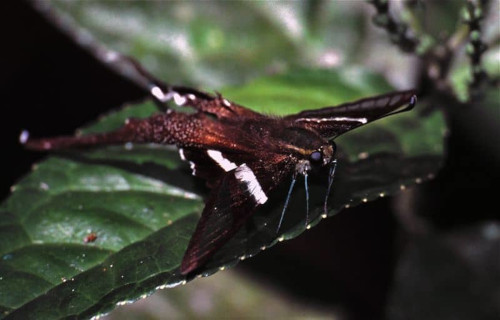
CCL: https://bit.ly/1jxQJMa
Green Dragontail Facts
- Next up in this compendium of 5 Stunning Asian Lepidoptera comes the amazing species bearing the name of the Green Dragontail.
- Perhaps most notably, the gorgeous Green Dragontail does not yet appear on the well-known Red List of the IUCN. However, that may soon change, given the rate at which its native habitat continues to vanish.
- In addition, entomologists currently recognize a surprising total of 10 subspecies of this impressive invertebrate. This qualifies as remarkable, given that all of them inhabit the same immediate region of the world.
- Furthermore, this outstanding creature remains famous among lovers of Lepidoptera for the unique movement of its wings. That holds true because, in flight, the distinctive structures appear to wave and weave in the air.
- Finally, like many species this remarkable creature now faces the escalating threat of extinction. Also, as is often the case, its primary threats include the very real dual dangers of climate change and habitat loss.
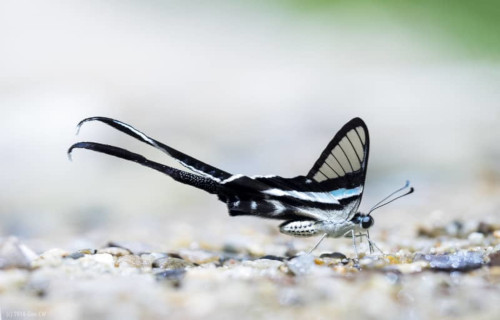
CCL: https://bit.ly/1eBd9Ks
Green Dragontail Physical Description
Firstly, the magnificent Green Dragontail proves that size bears no relation to beauty. That’s because the stunning Lepidoptera only attains a small wingspan. In fact, the species attains an average wingspan of only 1.6 – 2.2 in (4 – 5.5 cm).
However, the common name for the insect remains rather misleading. That’s because the marvelous invertebrate actually only displays a tiny amount of green. Further, this color pattern appears in a small stripe running along the wings and tail.
Yet, the majority of the body of the tiny invertebrate displays a dramatically different pattern of colors. Due to this, the predominant color pattern consists of black. Yet, numerous small white patches appear on the delicate wings.
Finally, the amazing creature does display the trait of sexual dimorphism, like many related species. But, it does so only to a very small degree. In its case, the females of the species typically present a somewhat duller appearance in the pattern of colors.
- Kingdom: Animalia
- Phylum: Arthropoda
- Class: Insecta
- Order: Lepidoptera
- Family: Papilionidae
- Genus: Lamproptera
- Species: L. meges
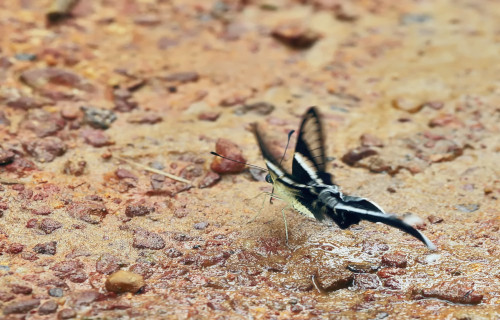
CCL: https://bit.ly/2UH5bJo
Green Dragontail Distribution, Habitat, and Ecology
Not at all surprisingly, the breathtaking Green Dragontail inhabits a rather moderate-sized range. Further, this area of habitation mostly consists of northeastern India, in Asia. But, scattered populations also inhabit other portions of the region.
However, even within that range it typically prefers to live in highly specific areas. Due to this, individuals almost always appear near waterways and streams. Further, these virtually always occur near patches of open ground, exposed to sunlight.
Additionally, most individuals occupy such areas that also happen to appear in a specific altitude range. This highly specific range extends from about 330 – 4,990 ft ( 100 – 1,520 m) in elevation. The exact reason for this remains a complete mystery.
In addition, the remarkable arthropod most commonly takes to the air between the months of April and October. Finally, like many of its related species, after mating the female typically lays the eggs on or near certain host plants.
Giant Atlas Moth
Giant Atlas Moth Facts
- Holding the third spot among our choices for inclusion in this list of 5 Stunning Asian Lepidoptera is the awesome Giant Atlas Moth.
- Perhaps most notably, the aptly named Giant Atlas Moth ranks as one of the largest species of Lepidoptera in the world. In point of fact, only one known species possesses a greater wingspan. Meanwhile, another species has a slightly greater surface area. Quite understandably, its common name derives from the famous Titan Atlas, from Greek mythology.
- For the moment, the population numbers of this gorgeous arthropod across its native range appear to be reasonably stable. For that reason, the IUCN does not presently list the insect on its Red List of Threatened Species. However, that status could easily change in the future, depending on various ongoing factors currently being seen around the world.
- While this particular species inhabits a sufficiently large area of the world, it nevertheless now faces several threats to its continued existence. One of these dangers consists of habitat loss, as humans encroach on more and more of its habitat. However, it also faces the threat posed by climate change, much like other species presently do.
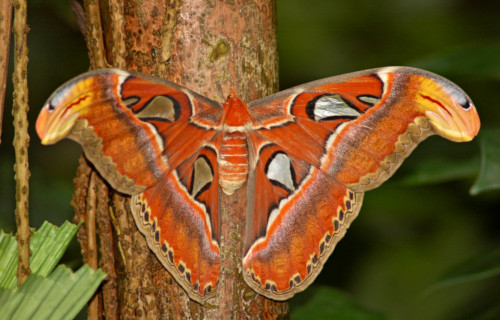
CCL: https://bit.ly/2Hdk8Lg
Giant Atlas Moth Physical Description
The most readily noticeable physical trait of the stunning Giant Atlas Moth, not surprisingly, given its common name, remains its great size. That’s because mature individuals of the species attain an average wingspan totaling roughly 9.4 in (24 cm). Furthermore, these remarkably large and powerful wings develop an overall surface area that totals roughly 25 sq in (160 sq cm).
However, the amazing arthropod also displays a moderate degree of sexual dimorphism, like most related species. In its case, though, this physical trait presents itself in a total of three different ways. The females of this marvelous Lepidoptera typically have a greater wingspan and girth than males. Meanwhile, males develop significantly broader antennae.
But the body remains extremely small in relation to the large wings. The upper portion of the wings present a reddish-brown color. Yet, these also display a pattern of white, pink, black, and purple lines. Furthermore, light colored, triangular-shaped patches also appear, bordered in black. Meanwhile, the underside remains much paler. Finally, an extension on the tip of each wing closely resembles the head of a snake.
- Kingdom: Animalia
- Phylum: Arthropoda
- Class: Insecta
- Order: Lepidoptera
- Family: Saturniidae
- Genus: Attacus
- Species: A. atlas
Giant Atlas Moth Distribution, Habitat, and Ecology
Firstly, the truly magnificent Giant Atlas Moth inhabits an expansive territorial range that covers much of the southeast portions of Asia. But, the fabulous invertebrate also appears to be especially prevalent on the island of Borneo. However, this truly fascinating species of moth also inhabits large sections of China, India, and the Malay Peninsula. Scattered groups also appear in other areas.
Within this region, it primarily inhabits areas of lush, tropical forests. However, smaller populations also thrive in secondary forests, and shrublands. The choice of habitat plays a key role in its survival, due to the fact that its caterpillar form relies entirely on the local plants for food. The larvae feed voraciously, and primarily on the foliage of citrus and evergreen trees.
Unfortunately, the adult lifespan of the moth lasts for only 1-2 weeks once the individual opens its wings. During this time the individual subsists entirely on fat reserves which it accumulated during its larval stage. This holds true due to the fact that adults do not possess functioning proboscis. Therefore, it flies as little as possible after leaving its cocoon. In point of fact, most females rarely move at all. These wait for males, mate, then die, averaging an adult life stag of only 1-2 weeks.
Purple Emperor
Purple Emperor Facts
- The next of our selections for inclusion in this article about 5 Stunning Asian Lepidoptera is the wide-ranging Purple Emperor.
- Firstly, the impressive title serves as the name for a gorgeous Eurasian butterfly of the Nymphalidae family. Quite confusingly, however, another butterfly native to another region bears the same common name.
- Unfortunately, throughout its habitat range, its numbers have declined sharply since the early 20th century. The principal reason for this appears to be habitat loss. But, climate change also seems to be a contributing factor in this.
- However, its current population appears to be relatively stable for the moment. Therefore, the IUCN currently lists the beautiful Lepidoptera as Least Concern. Thankfully, conservation efforts are in place across much of its range.
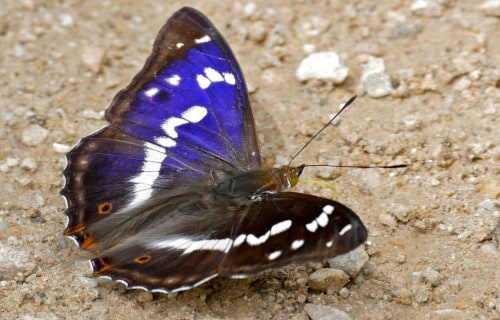
CCL: https://bit.ly/1jxQJMa
Purple Emperor Physical Description
Most notably, the magnificent Purple Emperor, like many related species, displays a slight degree of sexual dimorphism. In its case, this occurs because the females grow to a slightly larger size than the males.
Furthermore, as a result of this genetic trait, the smaller males attain an average adult wingspan of about 3.1 in (7.9 cm). Meanwhile, the somewhat larger females attain an average wingspan of roughly 3.6 in (9.2 cm).
In addition, the adults of this particular arthropod have dark brown wings with white bands and spots. However, numerous small orange rings typically appear on each of the hindwings, creating as quite striking appearance.
But, one small physical distinction also separates the males of the species from the females. That’s because, while a little smaller in size, the wings of the males usually display an almost iridescent purple sheen that the females lack.
- Kingdom: Animalia
- Phylum: Arthropoda
- Class: Insecta
- Order: Lepidoptera
- Family: Nymphalidae
- Genus: Apatura
- Species: A. iris
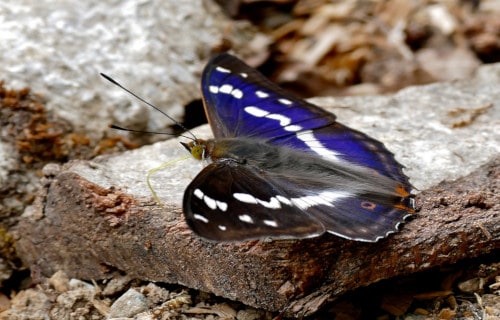
CCL: https://bit.ly/1jxQJMa
Purple Emperor Distribution, Habitat, and Ecology
First of all, the fabulous Purple Emperor butterfly has a rather wide area of distribution. This region includes southern Great Britain, and suitably temperate parts of Asia. This area of habitation also extends to central and western China.
Further, this invertebrate has a highly specific type of habitat that it seeks out. It rarely occurs outside of this type of area. Most notably, this preference consists of dense, broad-leaved woodlands, especially in central Europe.
The females of the Purple Emperor species spend most of their lives in the tree canopy. There, they seem to favor dense and mature oak forests. These only come down only to lay eggs in the small bushes that grow in clearings.
Additionally, the majority of the males also spend much of the time in the treetops. There each individual fiercely defends its territory from rivals. However, it will sometimes descend to drink from puddles or feed, as the need arises.
Finally, distinctly different from most butterflies, it does not feed on flowers. Instead, it feeds primarily on the honeydew secreted by aphids. Yet it will also feed on sap oozing from oak trees, on dung, urine and animal carcasses.
Bhutan Glory
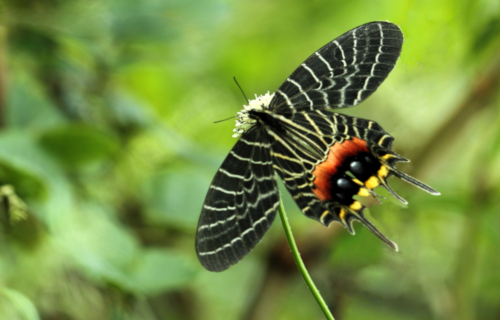
CCL: https://bit.ly/2SbZ5yN
Bhutan Glory Facts
- The fifth and final entry in this compendium of 5 Stunning Asian Lepidoptera, the Bhutan Glory, sits there only due to random selection.
- Most notably, Bhutan Glory serves as the much more pronounceable common name for the visually stunning Bhutanitis lidderdalii. By either name, this truly magnificent species of butterfly presently remains a subject of some debate among members of the scientific community. Further, this scientific debate has been ongoing for an extensive period.
- That’s because this somewhat heated debate goes back all the way to the time of its discovery by William Stephen Atkinson, in 1873. Beginning at that time, and continuing until today, numerous local entomologists consider the invertebrate to be rare. However, the IUCN presently lists the remarkable species as Least Concern, on its Red List of Threatened Species.
- However, the organization bases that placement on the nature of its moderately broad range of distribution. But most of that range consists of regions that are currently experiencing several conditions that greatly exacerbate its situation. In fact, one subspecies of the Lepidoptera in the region has already become extinct due to these conditions.
- Firstly, the awesome Bhuan Glory faces its most immediate threat from habitat loss. This holds true due to the ongoing deforestation of its native habitat. Secondly, its population also suffers losses due to ongoing illegal collecting for trade. But it also now faces the same looming threat that many other species around the world now face, that of climate change.
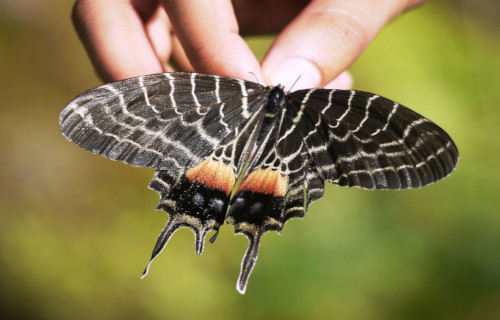
CCL: https://bit.ly/37k9yg9
Bhutan Glory Physical Description
Firstly, the magnificent Bhutan Glory qualifies as a comparatively large variety of butterfly. Secondly, however, it does differ from the majority of related species in one way. That’s due to the fact that the fascinating invertebrate species displays no noticeable degree of the trait of sexual dimorphism.
This holds true partly due to the fact that mature individuals of both genders attain precisely the same average wingspan. That typical wingspan measures roughly 4.3 in (11 cm). Furthermore, both genders of the beautiful creature typically display exactly the same patterns of color and markings.
The upper side of the Bhutan Glory wings usually presents a dull black in color. This pattern provides camouflage in the shade of the trees. Also, very thin, cream-colored striations also remain visible on both sexes. These features cross the wings in a vertical manner, creating a striking appearance.
In addition, again differing from most other butterflies, the underside of the wings display patterns similar to the upper side. However, in a wonderful contrast, small colored patches appear at the base of both the upper and lower wings. Meanwhile, the body itself primarily displays black, with grayish-green markings.
- Kingdom: Animalia
- Phylum: Arthropoda
- Class: Insecta
- Order: Lepidoptera
- Family: Papilionidae
- Genus: Bhutanitis
- Species: B. lidderdalii
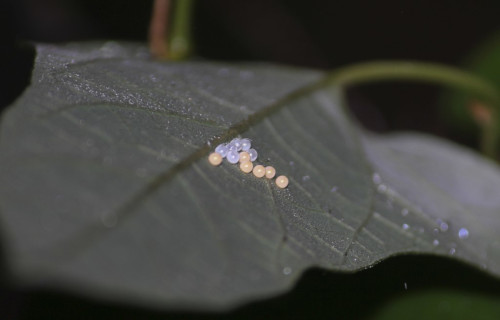
CCL: https://bit.ly/3bqlDn8
Bhutan Glory Distribution, Habitat, and Ecology
Quite unfortunately, the extent of the original habitat range of the Bhutan Glory remains unclear. However, its populations presently remain limited to only a few locations, including Bhutan. This serves as the source of the common name. Additional regions of habitation also include parts of Southeast Asia and Northeast India.
Yet, even within this range, the beautiful Lepidoptera has very specific habitat requirements. That’s because, within this area, individuals generally inhabit altitudes ranging between 5,000-9,000 ft (1,524-2,743 m). Further, for reasons still unknown, the butterfly usually prefers forests on mountain ridges to valleys.
This Bhutan Glory evolved specialized behavior patterns, advantageous for its environment. It typically moves slowly and erratically at treetop level. Coupled with its natural coloring, this often makes it difficult to see in the shadows. In this manner, individuals routinely travel from hilltop to hilltop.
But, its life cycle remained mystery to researchers until 2019. At that time, detailed observations occurred for the first time. After hatching, the larva of this marvelous insect goes through an astounding eight stages, as well as a pupal stage, prior to reaching adulthood. This takes about 188 days. Following this, the adult lives for an extremely long time for a butterfly, about 179 days.

CCL: https://bit.ly/2Cvf1Uh
5 Stunning Asian Lepidoptera
We sincerely hope that you have enjoyed this article about 5 Stunning Asian Lepidoptera. This portion of the world contains much incredible natural beauty. Obviously, these few represent only the tiniest portion of the total number of Lepidoptera throughout the world. But, we hope that learning a little about them has whet your appetite to know more. We also hope that mankind will do all it can to protect and preserve such examples of the wonders of Nature, wherever they occur.
Check out our other articles on Breathtaking Primates of the World, Havasu Falls, Bagheera kiplingi, Earth’s Many Mesmerizing Cephalopods, Rare North American Flowering Plants
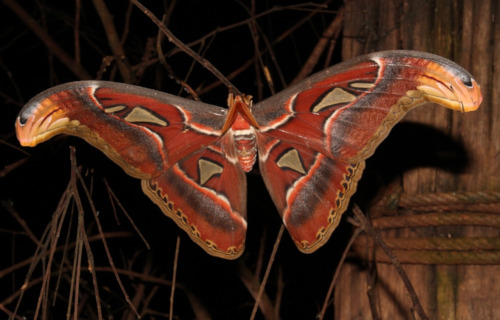
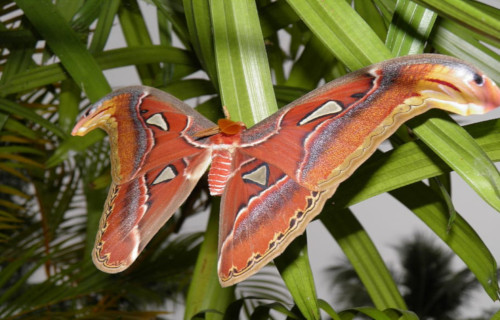
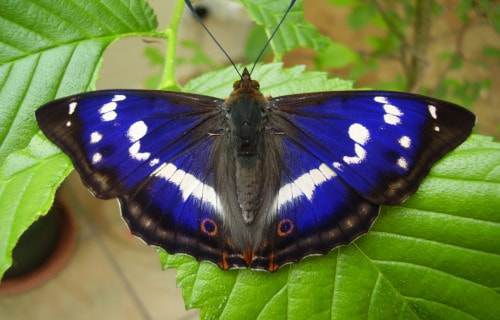









Leave a Reply